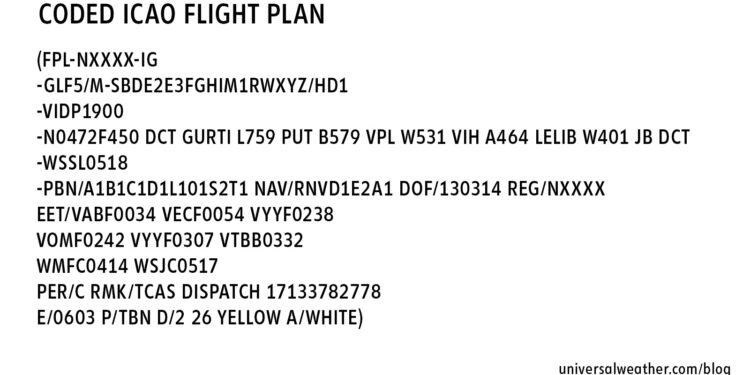Flight Planning, Weather & NOTAMS for Singapore

This is a post by author Yvonne Chan. Yvonne is Managing Director for Universal Aviation Singapore, which has an aircraft ground-handling facility in Seletar. Yvonne is an expert on business aircraft operations in Singapore and can be contacted at yvonnechan@universalaviation.aero.
This business aviation blog post is part of a series on operating in Singapore and continues from our last article: “Tips on Permits, PPRs and Airport Slots for Singapore.”
While flight plans, weather, and NOTAMS can be filed and sourced directly by business aircraft operators, it’s recommended that you use a 3rd-party provider and a ground handler as resources in this process. Be aware of local Singapore operating restrictions as well as best-practice procedures in filing and revising flight plans.
1. Consider Air Traffic Control (ATC) procedures prior to operation
You’ll need to obtain arrival and departure airport slots when operating to Changi (WSSS). Always check NOTAMS before operating to either WSSS or Seletar (WSSL). Prior to arrival, the Changi Airport Group (CAG), responsible for managing the airport, will advise ATC of your assigned parking bay. ATC will communicate this to the crew on arrival.
2. Minimum equipment requirements exist at this location
All aircraft operating to Singapore must have airborne collision avoidance system (ACAS II) as well as reduced vertical separation minima (RVSM) certification.
3. Know preferred means of communication
E-mail, rather than SITA or AFTN, is preferred in ground handler communications with ATC. Any departure delay will be communicated by ATC to the crew via VHF. Permission must be obtained from ground control for engine start (this will be via VHF).
4. Consider day of operation procedures
On the day of operations, your 3rd-party provider will ensure that your flight plan package is printed and ready for the crew and will confirm that the ATC flight plan is correctly filed. If there’s an error or issue with the flight plan filing, your ground handler will coordinate necessary changes. In the case of a flight plan self-filed by the operator, the ground handler will advise of appropriate changes that may be necessary (i.e., if routing is not correct). A delay of more than three hours will require a new flight plan instead of revising one that was originally filed. Your ground handler will be able to provide ATC with the new flight plan. However, if you require a computerized flight plan, this will need to be sourced through a 3rd-party provider.
5. New holding patterns are in place at WSSS
On March 19, 2012, Civil Aviation Authority of Singapore (CAAS) issued an AIP supplement regarding an operational trial in holding-area procedures when approaching WSSS airspace (whenever traffic circumstances require holding of aircraft). Foreseeable circumstances for holds would include peak periods of arrival into WSSS, inclement weather, and transition during change of runway in use. Check with your 3rd-party provider on current status and procedures for the four newly designated holding areas.
6. Be aware of restricted and military airspace
There are areas of restricted airspace around Singapore, so it’s important to confirm you’re using correct airways. Singapore is a small country, in very close proximity to Malaysia and Indonesia, with military areas and activity close by. When operating to or from WSSL, be aware there are special procedures that must be followed. Airspace closures due to military exercises are advised in advance via NOTAM. During Singapore Air Defense exercises, there will be special departure procedures to follow for certain sectors. Once airborne, crew will communicate with ATC regarding any revised routings, but this doesn’t usually cause delays.
7. There are weather challenges to consider
During periods of heavy rain and lightning, most prevalent between October and March, you may experience operational delays, particularly at WSSL. WSSL has no instrument landing system (ILS), and the airport may close to all aircraft arrivals and departures during periods of heavy rain and lightning. Low-visibility-haze conditions still occur from time to time as a result of forest clearing activities in Indonesia, but the situation has improved over the past few years.
8. Be aware of local weather resources
There are fully staffed meteorological departments at both WSSS and WSSL able to provide worldwide weather. There’s also a local Web site that you or your ground handler can access to print off local weather and NOTAMS. Note that this site is geared to the Singapore region only.
9. Know pre-departure weather options
Your ground handler will ensure that a weather package including NOTAMS is printed and ready for the crew. Current weather validation, as well as the latest METARs and TAFs, can be obtained from the local met office or control tower.
Conclusion
Operational delays, in practice, are relatively rare in Singapore. Heavy weather activity is more prone to disrupt arrivals and departures at WSSL as opposed to WSSS. Airspace restrictions due to military activity are not infrequent, and you’ll need to be aware of these limitations. However, such events seldom cause operational issues.
Questions?
If you have any questions about this article, contact me at yvonnechan@universalaviation.aero.
Later we’ll discuss local culture considerations for Singapore and their impact on your trip.




